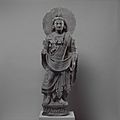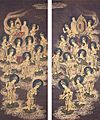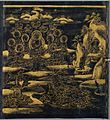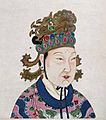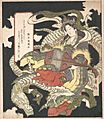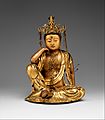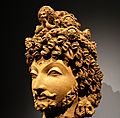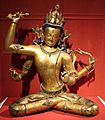Bodhisattva facts for kids
|
Basic terms |
|
|
People |
|
|
Gautama Buddha |
|
|
Schools |
|
|
Practices |
|
|
study Dharma |
|
A bodhisattva is a special person in Buddhism. They are on a journey to become a Buddha, which means someone who is fully awake and enlightened. Even though they have reached a high level of enlightenment (a deep understanding of life), they choose not to enter Nirvana. Instead, they decide to stay in the world to help all living beings find peace and happiness.
The word Bodhisattva can also mean specific, very famous bodhisattvas. Some examples are Avalokiteshvara, who represents compassion, Manjushri, who represents wisdom, and Vajrapani, who represents power.
Many bodhisattvas make a special vow or promise. This vow guides how they help people. For example, a bodhisattva named Kshitigarbha promised not to become a Buddha until all beings suffering in difficult places were free. Some Buddhas, like Amitabha, also made important vows when they were bodhisattvas. They became Buddhas once these vows were completely fulfilled.
Contents
Who are Bodhisattvas?
Bodhisattvas are like spiritual heroes. They are very kind and wise. They want to help everyone overcome their problems and find inner peace. They believe that true happiness comes from helping others.
The Path to Buddhahood
Becoming a Buddha is a long journey. A bodhisattva is someone who is far along this path. They have learned a lot about how the world works and how to be truly happy. But instead of just focusing on their own happiness, they choose to share their wisdom and help others.
Why They Stay in the World
Bodhisattvas could enter a state of perfect peace called Nirvana. But they see that many beings are still struggling. So, they decide to wait. They stay in the world to guide and support others. They believe that no one should be left behind on the path to happiness.
Important Bodhisattvas
There are many different bodhisattvas, each with their own special qualities.
Avalokiteshvara: The Bodhisattva of Compassion
Avalokiteshvara is one of the most well-known bodhisattvas. This bodhisattva is famous for having great compassion. Compassion means feeling deep care and wanting to help others who are suffering. Avalokiteshvara is often shown with many arms. These arms symbolize all the ways they can reach out and help living beings. In some parts of Asia, Avalokiteshvara is known as Guanyin and is seen as a female figure.
Manjushri: The Bodhisattva of Wisdom
Manjushri is the bodhisattva who represents wisdom. Wisdom is about understanding things deeply and clearly. Manjushri is often shown holding a sword. This sword is not for fighting. Instead, it cuts through confusion and ignorance. It helps people see the truth and make smart choices.
Vajrapani: The Bodhisattva of Power
Vajrapani is a powerful bodhisattva. They represent strength and energy. Vajrapani helps people overcome fears and challenges. They protect those who are trying to follow the Buddhist path. Vajrapani is often shown holding a thunderbolt, which symbolizes strong spiritual power.
Bodhisattva Vows
A vow is a serious promise. Bodhisattvas make special vows that guide their actions. These vows show their strong commitment to helping others.
Kshitigarbha's Great Vow
One famous example is Kshitigarbha. This bodhisattva made an amazing vow. Kshitigarbha promised not to become a Buddha until all beings suffering in difficult realms were free. This shows incredible dedication and kindness. Kshitigarbha is often seen as a protector of children and travelers.
Buddhas Who Were Bodhisattvas
Some Buddhas, like Amitabha, were once bodhisattvas. When they were bodhisattvas, they made many vows. They worked hard to fulfill these promises. Once all their vows were completed, they became Buddhas. This shows that the path of a bodhisattva can lead to becoming a Buddha.
See also
Images for kids
-
Gandharan relief depicting the bodhisattva (future Gautama Buddha) taking a vow at the foot of Dipankara Buddha, Art Institute of Chicago.
-
Gilded bronze statue of Tara, Sri Lanka, 8th century CE.
-
Bronze statue of the bodhisattva Avalokiteśvara. Sri Lanka, c. 750 CE.
-
Greco-Buddhist standing Maitreya (3rd century), Metropolitan Museum of Art, New York
-
Wood carving of Avalokiteśvara. Liao China, 907–1125
-
Bodhisattva Prajñaparamita, a female personification of the perfection of wisdom, Singhasari period, East Java, Indonesia, 13th century
-
Mural of bodhisattva Padmapani in Ajanta Caves. India, 5th century
-
Green Tara attended by White Tara and Bhrikuti, India, Madhya Pradesh, Sirpur, c. 8th century.
-
Japanese statue of Kannon (Guanyin, a popular female form of Avalokiteshvara in East Asia)
-
Mural painting of Manjushri in tantric union with his consort, the bodhisattva Sarasvati (also considered to be a form of Tara).
-
Green Tara and her devotees, Folio from a Bengali manuscript of the Aṣṭasāhasrikā Prajñāpāramitā (Perfection of Wisdom in Eight Thousand Lines), MET.
-
Maitreya, 13th century, Kamakura period, Tokyo National Museum, Important Cultural Property of Japan.
-
Statue of Ksitigarbha, the background art depicts his pure land and attendant bodhisattvas. From a Buddhist temple in Ho Chi Minh City, Vietnam.
-
Empress Wu Zetian
-
Japanese illustration of Benzaiten, seated on a white dragon. Some Japanese sources associate this figure with the naga princess in the Lotus sutra.
-
Standing bodhisattva. Gandhāra, 2nd–3rd century.
-
A rock carving of Avalalokiteshvara, Weligama, Sri Lanka
-
Silver Manjushri, Sailendra, early 9th century Central Java, National Museum.
-
Samantabhadra, Yulin Cave 3, Western Xia
See also
 In Spanish: Bodhisattva para niños
In Spanish: Bodhisattva para niños











